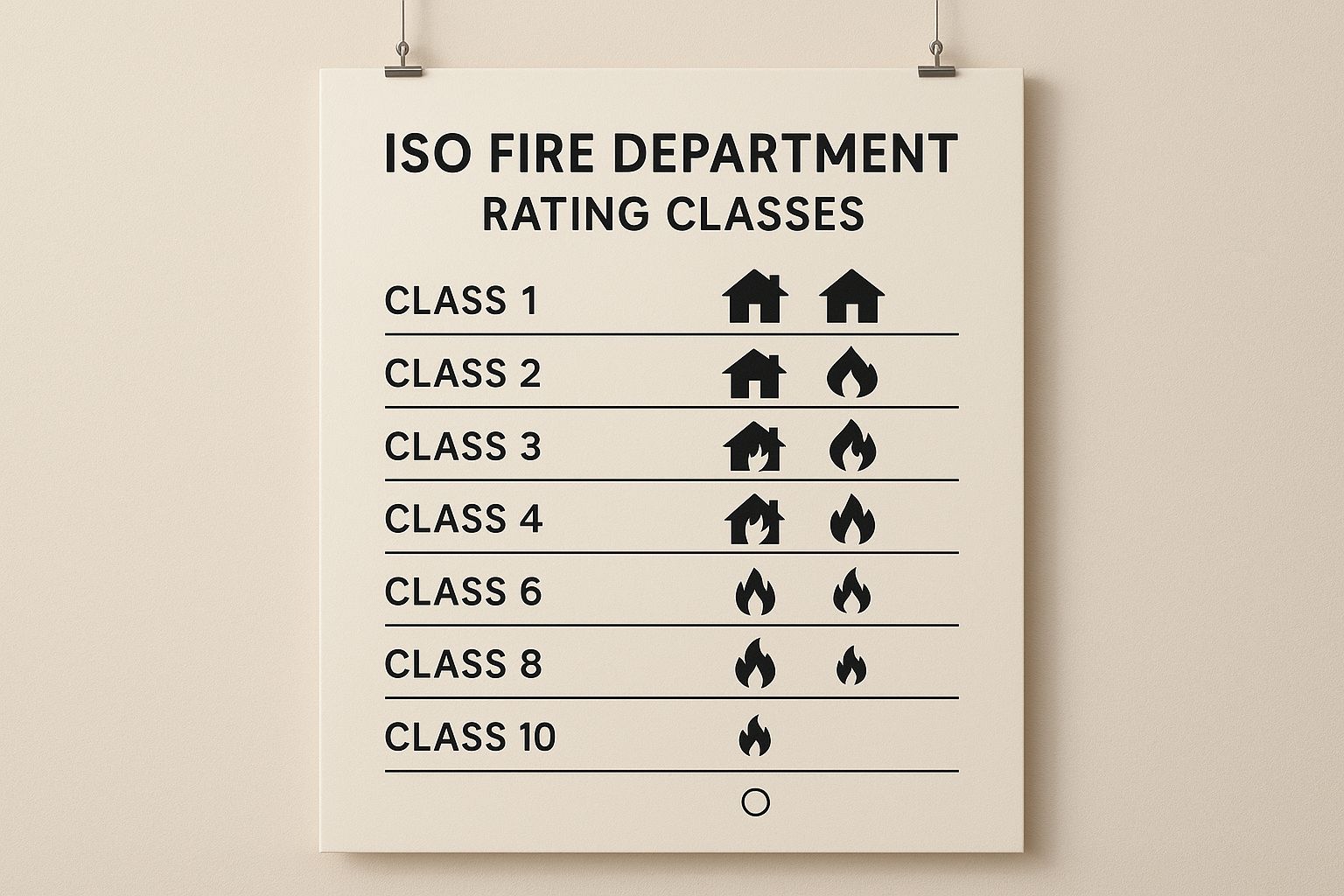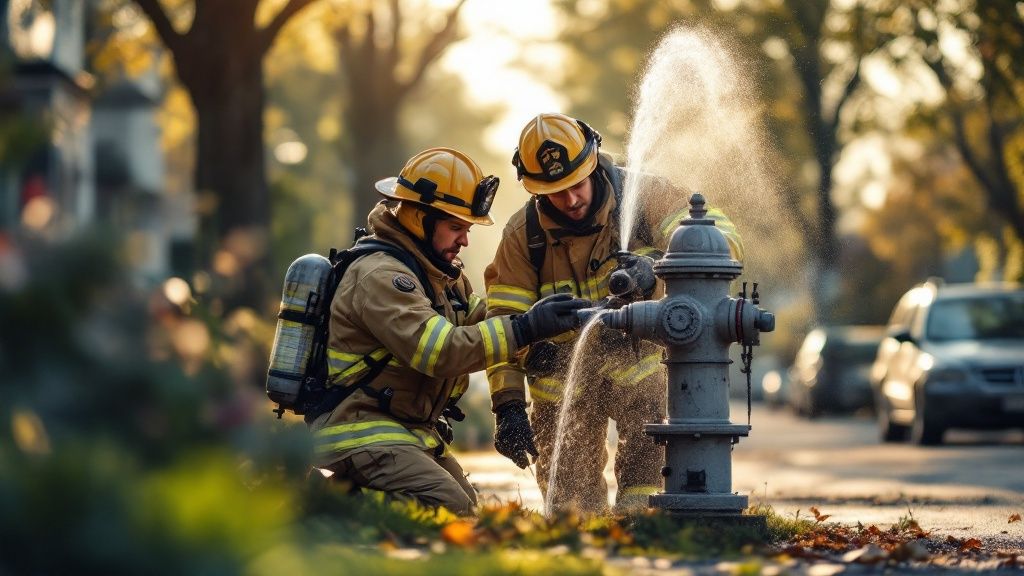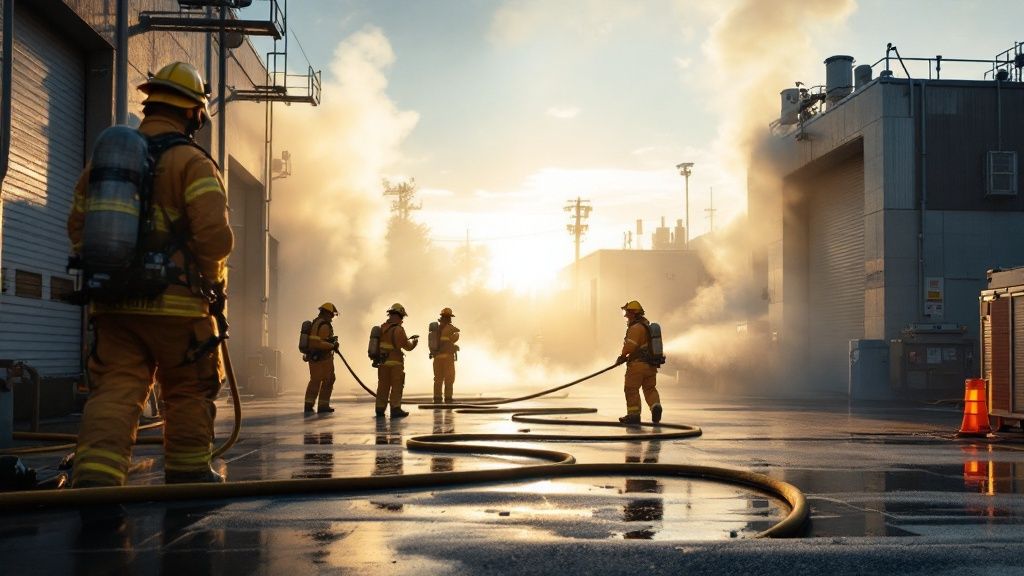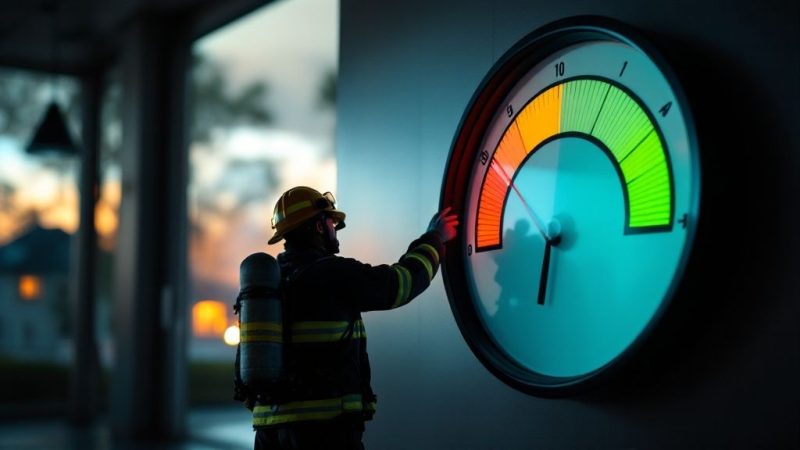Improve ISO Ratings for Fire Departments & Lower Insurance Costs
Ever heard of an ISO rating? Think of it as a report card for your community's fire readiness, graded on a scale from Class 1 (the best) all the way down to Class 10 (needs serious improvement).
This score, officially called the Public Protection Classification (PPC), is a huge deal because it directly impacts what homeowners and businesses pay for property insurance. A better rating tells insurers there's lower risk, which can translate into some pretty significant savings on your annual premiums.
What Are ISO Ratings and Why Do They Matter?
At its core, an ISO rating is a standardized way to measure just how well-equipped your local fire department is to protect your property. This isn't just about how fast a fire truck shows up at your door; it’s a deep dive into the entire fire suppression system in your community.
The whole point is to give insurance companies a solid, data-driven tool to figure out fire risk when they're writing policies. When a department improves its score, it’s not just an internal pat on the back—it’s a community-wide economic win that can save every property owner real money.
The Financial Power of a Good Score
The link between an ISO rating and your wallet is actually pretty simple: lower risk means lower cost. Insurance companies lean heavily on the PPC score as a key part of their underwriting process.
A practical example: Imagine your community improves from a Class 4 to a Class 2. For a local business with a $1 million property, this jump could easily reduce their annual insurance premium by 5-10%, saving them between $500 and $1,000 every single year. These savings directly improve their bottom line, freeing up cash for growth or hiring.
It just makes sense. A community with a strong, well-equipped fire department and reliable water sources is a lot less likely to suffer catastrophic fire losses. That reduced risk gets passed on to you in the form of lower insurance premiums.
A better ISO score is one of the few community-wide investments that provides a direct financial return to every single property owner. By funding improvements in fire protection, a community is effectively lowering the cost of living and doing business for everyone within its boundaries.
How the Grading System Works
The Insurance Services Office (ISO) uses a comprehensive framework called the Fire Suppression Rating Schedule (FSRS) to evaluate fire departments. This system scores four main areas to come up with the final PPC grade.
The whole thing adds up to 100 possible points, plus some opportunities for extra credit. A Class 1 rating represents truly exemplary fire protection. It’s a high bar to clear—only a select group of agencies, like the Virginia Beach Fire Department (ISO Class 2), manage to achieve these top-tier ratings.
Improving a community's rating is a massive team effort. We've seen it happen in places like Broward County, Florida, where better scores led to documented insurance cost reductions for residents. If you want to see more examples, you can check out a list of accredited agencies and their ISO ratings on the CPSE website.
How ISO Calculates Your Community Score
To really get a handle on that final Class 1 through 10 score your community receives, you have to look at the grading rubric first. The Insurance Services Office (ISO) doesn’t just pull a number out of thin air; they use a detailed framework called the Fire Suppression Rating Schedule (FSRS). This schedule takes a hard, meticulous look at four critical areas of your community’s fire protection services.
Think of the FSRS as a point-based system, with a total of 105.5 points up for grabs. Each category is weighted differently, which tells you how much importance ISO places on it for suppressing a fire. Getting a solid grasp of these categories is the first step to improving your ISO rating and, in the long run, saving your community some serious money on insurance.
Breakdown of the ISO Fire Suppression Rating Schedule (FSRS)
The final ISO rating is a composite score that comes from an in-depth analysis of your community's capabilities. The table below lays out the four main categories ISO evaluates to determine a community's Public Protection Classification (PPC) score and shows the maximum points available for each.
| Evaluation Category | Maximum Points | Key Factors Assessed |
|---|---|---|
| Emergency Communications | 10 | 911 call processing, telecommunicator training, dispatch protocols, and system redundancy. |
| Fire Department | 50 | Staffing levels, training records, fire station locations, apparatus/equipment condition, and maintenance. |
| Water Supply | 40 | Hydrant inspections, water flow and pressure, and overall capacity of the municipal water system. |
| Community Risk Reduction | 5.5 (Bonus) | Public education, fire code enforcement, and fire investigation programs. |
As you can see, the fire department's capabilities and the water supply system carry the most weight, making up a combined 90% of the core score.
The Four Pillars of the FSRS Score
Let's dive a little deeper into how the points break down across these key evaluation areas.
-
Emergency Communications (10 points): This pillar is all about how your 911 dispatch center handles emergency calls. It's not just about picking up the phone; ISO scrutinizes the entire workflow, from the moment a call comes in to the second first responders are dispatched. Key factors here include the training of telecommunicators and the reliability of any backup systems.
-
Fire Department (50 points): This is the biggest piece of the puzzle. This category takes a deep dive into the fire department's core operations. ISO looks at everything from the number of firefighters on duty and their training records to how strategically your fire stations are placed. The age, condition, and maintenance logs for every single fire truck and piece of equipment are also critical components.
-
Water Supply (40 points): A fire department is only as effective as its water source. This section assesses how available and reliable water is for firefighting. Evaluators will check the inspection frequency of hydrants, the adequacy of water pressure across the community, and the overall capacity of the municipal water system.
Proactive efforts really count in an ISO review. A well-documented hydrant inspection program or a modern, well-maintained fleet can have a huge impact on your final score. It’s proof that consistent investment pays off.
Earning Bonus Points with Community Risk Reduction
Beyond those core three categories, ISO offers a little extra credit for departments that go the extra mile. The Community Risk Reduction (CRR) category provides up to 5.5 additional points for proactive public safety efforts.
This rewards departments for activities like:
- Conducting public fire safety education programs.
- Enforcing local fire codes through regular inspections.
- Performing thorough fire investigations to prevent future incidents.
Sometimes, these bonus points can be the deciding factor that bumps a community up into a better ISO class.
This chart shows how the final point total translates into one of the ten Public Protection Classification ratings, with Class 1 representing the absolute pinnacle of fire safety.

As the graphic makes clear, getting a top-tier rating demands excellence across multiple, interconnected systems—you can't just focus on one area and expect a great score.
The Real Financial Impact of a Better ISO Rating

This is where the rubber meets the road. All the training, equipment, and planning translate directly into real, tangible savings for your community. While every insurance company sets its own rates, they all lean heavily on the Public Protection Classification (PPC) score to gauge risk.
A better ISO rating for fire departments is a clear signal to insurers that a community is a safer bet. When risk goes down, premiums usually follow suit for everyone.
Think of it this way: money spent on your local fire department isn't just an expense line on a budget. It's a strategic investment that can put money back into the pockets of every single property owner in town.
A Practical Example of Savings
Let's break down what this looks like in the real world. Imagine a homeowner in a town with a respectable Class 5 rating. They pay $1,500 a year for property insurance.
Now, say that community invests in better apparatus, shores up its staffing, and improves its water supply. All that hard work pays off, and they jump to a Class 3 rating. This improvement could easily trigger a premium reduction of 10% to 15%. For that homeowner, that’s $150 to $225 saved every single year.
Multiply that across thousands of homes and businesses, and you start to see the massive collective benefit. Community-wide investments in fire services really do pay dividends for everyone.
Boosting Commercial and Community Value
And it's not just homeowners who see the benefits. A department's ISO rating has a huge influence on commercial property insurance cost, which can be a major factor for any business's bottom line. Companies are naturally drawn to communities with excellent public services—including top-tier fire protection—because it lowers their operating costs and overall risk.
An improved ISO rating does more than just lower insurance bills; it actively boosts property values and makes a community more attractive for new investment. It sends a clear message that the area is safe, well-managed, and a secure place to live and do business.
This creates a powerful cycle of growth. The money residents and businesses save can be spent locally, strengthening the community’s economic foundation.
Of course, managing all the complex data needed for an ISO review—from personnel records and training logs to incident reports—is a massive challenge in itself. Using a dedicated platform can make this whole process a lot simpler. You can explore different management and dispatching solutions to see how they help document the very improvements that lead to a better score.
Actionable Strategies to Improve Your ISO Score
Trying to improve your community's ISO ratings for fire departments isn't about one single, massive change. It’s really a game of inches—a series of smart, targeted improvements across the key areas of the Fire Suppression Rating Schedule (FSRS). Think of this as the playbook for earning more points and, just as importantly, delivering real savings to your community.
The very first step? Realizing that documentation is king. In an ISO review, if a training session or hydrant inspection isn't meticulously logged, it might as well have never happened. Every single action you take has to be backed up by clear, accessible records.
Fortify Your Water Supply Points
Your water supply is a huge piece of the puzzle, accounting for a massive 40% of your total score. This makes it the perfect place to focus for high-impact improvements. Small, consistent efforts here can rack up points faster than you’d think.
- Implement a Hydrant Color-Coding System: This is a simple, visual hack that saves critical seconds on a fire scene. For example, painting hydrant caps blue for high-flow rates (1,500+ GPM) and red for low-flow rates (under 500 GPM) helps your engine companies make faster, smarter decisions when every moment counts.
- Establish a Proactive Maintenance Schedule: Don't wait for a hydrant to fail during an emergency. A documented schedule for inspecting, flushing, and testing every hydrant annually does more than just ensure reliability—it gives ISO evaluators the exact paper trail they're looking for.
Enhance Fire Department Operations
With 50% of your score on the line here, optimizing your department’s internal operations is simply non-negotiable. This is all about dialing in your training, apparatus management, and staffing documentation.
The most common mistake departments make is assuming their hard work speaks for itself. Meticulous documentation is the language ISO understands. Your training logs, maintenance records, and response data are the evidence that proves your capabilities.
A prime example of a department that nailed this comes from the City of Oviedo, Florida. Starting with a Class 4 rating, the department zeroed in on acquiring new equipment and rolling out ISO-aligned training programs. By dedicating the resources and man-hours to meet specific ISO criteria, they jumped to a Class 2. It’s proof that sustained, measured effort directly leads to better iso ratings for fire departments. You can dive into their strategy in this detailed case study.
Streamline Training and Documentation
Your training program will be put under a microscope. ISO wants to see structured, consistent, and well-documented training for every single member of your department.
- Structure Your Training Logs: Don't just jot down dates and topics. Create detailed logs that spell out the specific objectives met, the duration of the training, the instructor, and the location for every session. Make sure it all aligns with the ISO-required hours for company, driver, and officer training.
- Develop a Data-Driven Apparatus Plan: Ditch the reactive approach to buying new trucks. Create a formal apparatus replacement schedule based on age, maintenance costs, and NFPA standards. This shows ISO you have a long-term strategy. Using modern software to track your operations can be a game-changer, and you can see a breakdown of helpful first responder management features that make this whole process much simpler.
By putting these concrete strategies into action, you're not just chasing a number. You’re building a clear path toward a lower ISO score, which translates directly into enhanced community safety and lower insurance costs for every property owner you protect.
Understanding ISO Standards Beyond Fire Departments

When you hear "ISO" in the fire service, your mind probably jumps straight to your department’s rating. And for good reason—it’s a critical benchmark in the U.S. public sector. But that’s just one slice of the pie. The ISO name actually stands for a massive global system of quality and safety standards that touches almost every industry imaginable.
The same core principles that evaluate a fire department’s readiness are also applied to private companies. It’s all about ensuring reliability and consistency.
This is a key distinction to make. The Public Protection Classification (PPC) program is all about gauging a community's ability to suppress fires. In contrast, other ISO certifications, like the well-known ISO 9001, zero in on a company’s internal processes. They’re designed to make sure a business delivers consistent quality in its products and services.
The Role of ISO in the Private Sector
Here’s a simple way to think about it: a department’s PPC score is the community’s report card for fire protection. An ISO 9001 certification is a company’s seal of approval, proving its commitment to operational excellence. This becomes incredibly important for businesses that make or install the very fire protection systems we rely on.
Take a company that installs commercial fire alarm systems. By earning ISO 9001 certification, they're not just meeting a baseline requirement. They’re proving to customers that their installation processes are documented, consistent, and repeatable, every single time. It's a huge trust-builder.
Practical Example: A fire department might require that any new sprinkler systems going into commercial buildings must come from an ISO 9001-certified manufacturer. This adds another layer of confidence, ensuring the gear is built to a high, repeatable standard, which directly boosts community safety.
Getting certified isn't just about external validation, either. It can be a serious money-saver for the business. Standardizing processes naturally reduces waste, minimizes errors, and makes everything more efficient. The result is lower operating costs and happier customers.
Connecting Global Standards to Local Safety
When the companies making our equipment are held to these high standards, it creates a much stronger fire safety ecosystem from top to bottom. It means the tools and systems your department depends on are built right from the very start.
Globally, a whole range of ISO standards helps build a comprehensive approach to fire risk. For businesses in the fire protection world, key certifications include ISO 9001 (Quality Management), ISO 45001 (Occupational Health and Safety), and highly specific technical standards like ISO 7240 for fire alarm systems. For instance, ISO 7240 lays out strict testing and maintenance protocols to guarantee system reliability, creating a solid baseline for both performance and legal compliance. You can read more about how these global frameworks enhance fire safety on pacificcert.com.
These international standards and the community-based PPC program are two sides of the same coin. One ensures the equipment is reliable, while the other ensures the team using it is ready. Together, they build a safer world.
At the end of the day, it's clear the drive for standardization doesn't stop at the firehouse door. It extends all the way to the factory floor and the installation crew, forging a chain of quality that everyone can depend on when it matters most.
Common Questions About ISO Ratings Answered
Trying to get your head around ISO ratings for fire departments can bring up a lot of questions, whether you're a homeowner, a firefighter, or a public official. Let's cut through the noise and get you some straightforward answers to the most common things people ask.
How Can I Find Out My Community's ISO Rating?
Figuring out your community's Public Protection Classification (PPC) score is actually simpler than you might expect. While ISO sends detailed reports directly to fire departments and insurance companies, property owners have a couple of direct ways to get this info.
The easiest route is to just call your property insurance agent. They use this exact rating to help figure out your premiums, so it's information they'll definitely have. Just ask them, "What is the current ISO or PPC rating for my address?"
You can also call your local fire department's non-emergency line. The fire chief or someone on the administrative staff will know their current rating and can usually give you some context on what it means for your community.
How Long Until Insurance Rates Drop After an Improvement?
This is a really important question, and the answer isn't "immediately." There's a process involved before you'll see a change in your insurance bill.
First, ISO has to finish its official review and formally issue the new, better classification. After that, they notify all the insurance companies about the change. From there, each insurance provider works on its own schedule to update its rates.
Typically, you can expect insurance rates to be adjusted at your next policy renewal period following the official notification. This could be anywhere from a few months to a year, depending on your insurer's cycle.
My advice? Once you hear your community's rating has improved, get on the front foot. A month or two before your policy is up for renewal, call your insurance agent. Make sure they have the updated PPC score on file and ask how it's going to affect your premium. This little bit of effort ensures you get those savings as soon as they're available.
Do Volunteer Fire Departments Get Scored Differently?
Nope. Volunteer and career fire departments are graded using the exact same playbook: the Fire Suppression Rating Schedule (FSRS). ISO's whole evaluation is built to be objective. It looks at performance, capability, and resources—not whether the firefighters get a paycheck.
That said, volunteer departments often run into unique challenges meeting certain benchmarks, especially around staffing and proving guaranteed response times. For example, ISO wants to see that a department can get enough people on scene quickly. That can be a lot harder for a volunteer agency to document compared to a career department with crews already on duty.
Here's a practical example: a volunteer department can seriously boost its score by putting a solid system in place to track response data and prove they have consistent turnout. Being able to show an ISO evaluator hard evidence that an average of 12 volunteers respond to structure fires within 8 minutes is huge. For complex documentation needs, many departments seek guidance, and you can find helpful resources through our official Resgrid support channels. At the end of the day, meticulous record-keeping is what demonstrates capability, no matter what kind of department you are.
At Resgrid, LLC, we provide the tools to help your department meticulously track training, response, and maintenance—all critical components for proving your capabilities during an ISO review. Simplify your documentation and build a stronger case for a better rating by visiting https://resgrid.com.

